
#Product Trends
Marine Salvage Rubber Airbags
Engineering Excellence in Underwater Recovery
Marine salvage rubber airbags have become indispensable tools in modern underwater recovery and marine engineering. Crafted from multi-layered, high-strength rubber reinforced with synthetic fibers like polyester or aramid, these airbags are designed to withstand extreme underwater conditions while providing unparalleled buoyancy. Their ability to lift submerged objects—ranging from shipwrecks and pipelines to offshore infrastructure—makes them vital for salvage operations, even at depths exceeding 100 meters.
Advanced Design and Capabilities
The airbags’ core strength lies in their hybrid construction. Layers of rubber and fabric are vulcanized to create a flexible yet robust structure capable of bearing pressures over 30 bar. This design ensures resistance to abrasion, saltwater corrosion, and punctures, even in challenging marine environments. Engineers can adjust buoyancy by regulating air pressure, allowing precise control when lifting irregularly shaped or fragile objects, such as historical artifacts or damaged vessels.
Versatile Applications
Beyond emergency salvage, these airbags are widely used in offshore construction, pipeline installation, and underwater archaeology. For example, in shipwreck recovery, multiple airbags are strategically positioned and inflated in stages to distribute lifting force evenly, minimizing structural stress. Similarly, offshore industries rely on them to deploy or retrieve heavy equipment, such as subsea manifolds or drilling components.
Eco-Friendly and Efficient
Unlike traditional metal lifting systems, rubber airbags reduce environmental disruption. Their lightweight, compact design enables rapid deployment, while non-toxic materials prevent marine pollution. Modern iterations integrate IoT-enabled sensors to monitor pressure and temperature in real time, enhancing safety and operational efficiency.
Future Innovations
As marine projects push into deeper waters, manufacturers are developing airbags with enhanced pressure tolerance and smart automation. Coupled with robotics, these tools are redefining underwater salvage as a safer, faster, and more sustainable practice.


